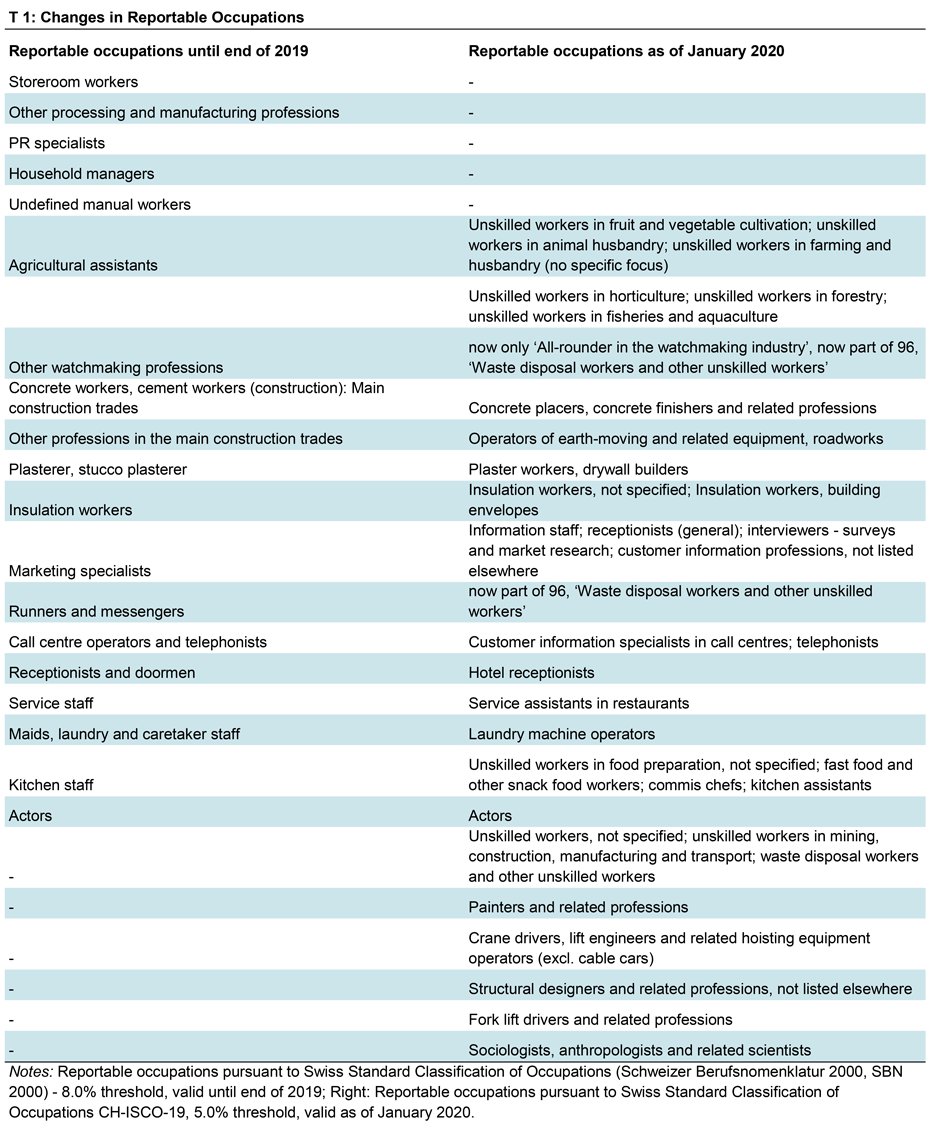The Amended Job Registration Requirement and Its Consequences
- Labour Market
- KOF Bulletin
Since July 2018, companies have been required to register any vacancies in professions with unemployment levels of more than 8% with the regional employment offices (RAV). As of 1 January, this threshold was lowered to 5% and the classifications of reportable professions were narrowed down. Despite the lower threshold, the effective scope of the job registration requirement has declined. On top of this, the bigger weight of the building sector will affect implementation.

After the immigration initiative was passed in 2014, parliament decided to introduce a job registration requirement in occupations with high unemployment. According to this requirement, employers are obliged to register vacancies that are subject to the registration requirement with the regional employment offices (RAV), and to hold back from advertising such jobs elsewhere for a period of five days. This gives the jobseekers on the RAVs’ books an information head start which helps their applications for the registered vacancies. At the same time, the job registration requirement stipulates that the RAVs provide the employers with files of suitable registered jobseekers within the first three working days of the job registration. The registration requirement aims to make better use of the domestic labour pool.
Only 25% of the unemployed use the information head start
According to the first monitoring report of the State Secretariat for Economic Affairs (SECO), companies seem to be complying with the job registration requirement: In the first year after introduction, the RAVs received around 120,000 registrations relating to a total of 200,000 reportable jobs. Over 80% of the reported vacancies concerned jobs in the hotel and catering, construction and industrial sectors. Not only do these figures exceed expectations, there is also potential for further growth. So far, jobseekers are not making full use of the information head start. To benefit, jobseekers registered with the RAVs must have a personal login to the arbeit.swiss portal and check the portal on a regular basis. However, an average of just 26% of the jobseekers in the reportable professions are registering for access to the protected section.
There is also room for improvement when it comes to the RAV's job placement services. Although the RAVs transferred a total of 195,000 personnel files in the three days after vacancy registration, there were no candidate submissions for close to 50% of the job registrations. According to SECO figures, the submitted personnel files resulted in employment in a total of 4,800 cases.
Painting and sociology jobs now also subject to registration requirement
Since 1 January 2020, the threshold has been lower and all professions with unemployment levels of 5% or above are subject to registration. At the same time, the new CH-ISCO-19 nomenclature will be applied for the first time to identify reportable jobs. Table T 1 presents the reportable occupations under the old nomenclature in the period July 2018 to December 2019, as well as the new reportable professions. Classifications were narrowed down in the majority of the occupations that remain subject to the registration requirement. For instance, now only vacancies for ‘service assistants in restaurants’ must be registered instead of ‘service staff’ in general. The same applies to kitchen staff, agricultural assistants and certain professions in the watch industry.

A number of occupations are no longer subject to the registration requirement this year, including PR specialists and household managers. Finally, aside from occupations such as painter and crane operator, sociologists have also been newly added to the list of reportable professions. Furthermore, as of 2020, the list also includes a mixed category, which combines unskilled workers in both construction and industry. The majority of the newly added occupations are jobs in the building sector.
Table T 2 quantifies the changes the amendments will trigger at the beginning of the new year. Two effects can be identified. As confirmed by SECO, the scope of the job registration requirement will be reduced as of 2020 although the threshold has been lowered from 8% to 5%. Before the first phase of the registration requirement, occupations with a total labour force of 310,000 and an average unemployment figure of 34,000 were expected to be subject to the registration requirement. As of 2020, the scope will decline to a labour force of 267,000 and an average unemployment level of 22,000.

Hence in 2020, reportable professions will comprise an expected 6.4% of the total active labour force and 22% of all jobseekers, compared to 7.6% of the active labour force and 25% of all jobseekers during the first phase of the reporting requirement. Secondly, there is a significant shift in reportable professions. The scope of the job registration requirement will decline in the hotel and catering industry (-80,000 employees), while more employees in the building sector will be subject to the registration requirement (minimum of +15,000). SECO mainly attributes the changes to the current low unemployment rates. However, the narrowing of the occupational nomenclature also contributes to this development.
Fewer jobseekers in the construction sector use the information head start
At present, it is not yet clear whether the registration requirement actually results in better use of the domestic labour pool and in a lower level of immigration of foreign personnel. The significant rise in registered jobs has created a positive framework. However, in the short run, the changes also throw up fresh challenges. The bigger share of the construction sector in the reportable professions hampers increased use of the information head start by the jobseekers. In the first phase of the registration requirement, as little as 12% to 16% of all jobseekers in the building industry registered with the arbeit.swiss job portal. In comparison, the share among PR specialists, who are no longer subject to the job registration requirement, was close to 50%.
As of next year, the RAVs will also be seeing more vacancy registrations for which few suitable candidate files existed in the first phase, and where submitted files rarely resulted in employment. While the RAVs were able to submit candidate files for 57% of the job registrations in the hotel and catering industry, and 7.4% of these submissions resulted in employment, in the building sector suitable files were only available for 36% of the reported vacancies and as few as 5.4% of the submissions resulted in employment.
Literature
SECO, 2018. Occupations subject to the reporting requirement - 8.0% unemployment threshold
SECO 2019a: Occupations subject to the reporting requirement - 5.0% unemployment threshold
SECO 2019b: external page https://www.arbeit.swiss/secoalv/de/home/menue/unternehmen/stellenmeldepflicht.html
SECO 2019c: external page https://www.seco.admin.ch/seco/de/home/seco/nsb-news.msg-id-76872.html
SECO 2019d: Vollzugsmonitoring Stellenmeldepflicht (execution monitoring - job registration requirement). First monitoring report by the State Secretariat for Economic Affairs (SECO)
Contacts
KOF Konjunkturforschungsstelle
Leonhardstrasse 21
8092
Zürich
Switzerland
KOF FB Konjunktur
Leonhardstrasse 21
8092
Zürich
Switzerland